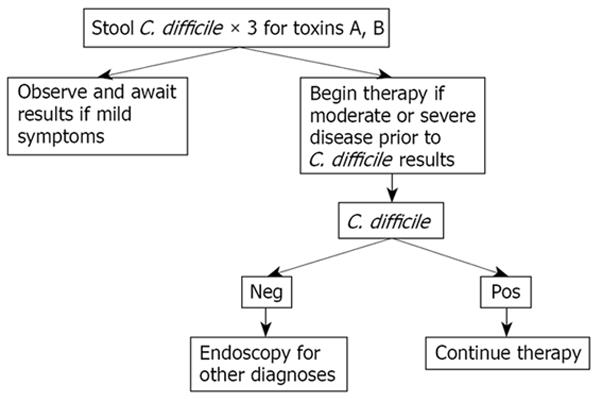Copyright
©2009 The WJG Press and Baishideng.
World J Gastroenterol. Apr 7, 2009; 15(13): 1554-1580
Published online Apr 7, 2009. doi: 10.3748/wjg.15.1554
Published online Apr 7, 2009. doi: 10.3748/wjg.15.1554
Figure 1 Approach to patients with suspected C.
difficile infection.
Figure 2 Initial therapeutic approach to patients with C.
difficile infection.
Figure 3 Trends in hospital stays associated with C.
difficile-associated disease, 1993-2005. (From Elixhauser and Jhung[82]) shows the trend in CDAD from 1993 through 2005. During the 8-year period from 1993 until 2001, the total number of hospital discharges with CDAD increased from approximately 85 700 to 148 900 per year, 74% increase. However, during the following 4-year period, from 2001 to 2005, the rate of increase for CDAD escalated, when the numbers of cases more than doubled to 301 200 (a 102 percent increase in 4 years). There were a total of 2 037 900 hospital discharges with CDAD over this 12-year period.
Figure 4 Discharge rate for C.
difficile-associated disease, per 10 000 hospital discharges, 1993-2005. (From Elixhauser and Jhung[82]) shows the number of CDAD discharges per 10 000 hospital discharges from 1993 through 2005. The findings are similar to those of the previous figure. From 1993 to 2001, the rate of CDAD per 10 000 discharges increased by 60% while the rate of increase from 2001 to 2005 was considerably steeper, 92%. Thus, the recent sharp rise in CDAD was not attributable solely to an increase in the number of hospital discharges.
-
Citation: Hookman P, Barkin JS.
Clostridium difficile associated infection, diarrhea and colitis. World J Gastroenterol 2009; 15(13): 1554-1580 - URL: https://www.wjgnet.com/1007-9327/full/v15/i13/1554.htm
- DOI: https://dx.doi.org/10.3748/wjg.15.1554












